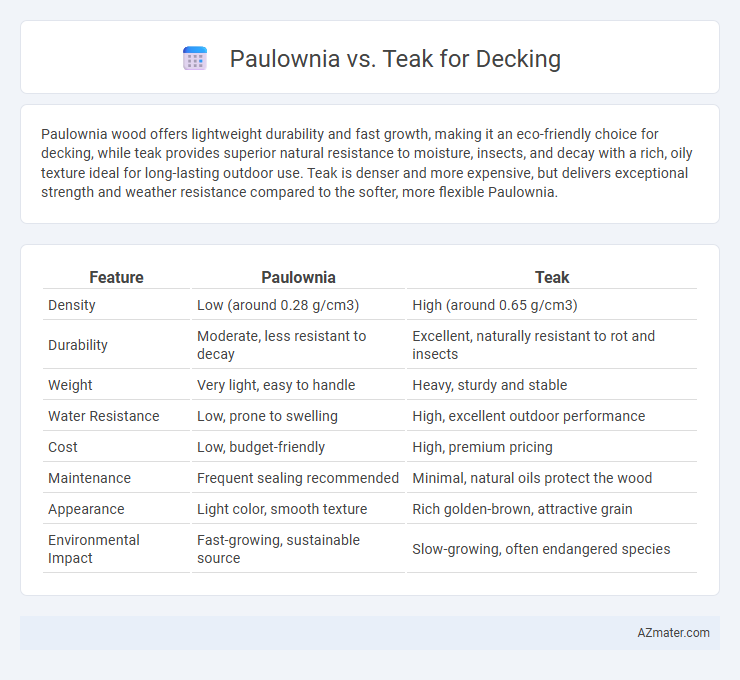Paulownia wood offers lightweight durability and fast growth, making it an eco-friendly choice for decking, while teak provides superior natural resistance to moisture, insects, and decay with a rich, oily texture ideal for long-lasting outdoor use. Teak is denser and more expensive, but delivers exceptional strength and weather resistance compared to the softer, more flexible Paulownia.
Table of Comparison
| Feature | Paulownia | Teak |
|---|---|---|
| Density | Low (around 0.28 g/cm3) | High (around 0.65 g/cm3) |
| Durability | Moderate, less resistant to decay | Excellent, naturally resistant to rot and insects |
| Weight | Very light, easy to handle | Heavy, sturdy and stable |
| Water Resistance | Low, prone to swelling | High, excellent outdoor performance |
| Cost | Low, budget-friendly | High, premium pricing |
| Maintenance | Frequent sealing recommended | Minimal, natural oils protect the wood |
| Appearance | Light color, smooth texture | Rich golden-brown, attractive grain |
| Environmental Impact | Fast-growing, sustainable source | Slow-growing, often endangered species |
Introduction to Paulownia and Teak as Decking Materials
Paulownia and teak are popular choices for decking due to their distinct properties and aesthetic appeal. Paulownia wood is lightweight, fast-growing, and resistant to warping and cracking, making it an eco-friendly and cost-effective decking option. Teak, known for its natural oils and dense grain, offers superior durability, water resistance, and a rich golden-brown color that enhances outdoor spaces.
Key Physical Differences: Paulownia vs Teak
Paulownia wood is significantly lighter and less dense than teak, making it easier to handle but less durable for heavy foot traffic. Teak has a high natural oil content and tight grain structure, providing exceptional resistance to moisture, decay, and insect damage, which Paulownia lacks. While Paulownia offers rapid growth and sustainability advantages, teak's superior hardness and longevity make it a premium choice for decking applications.
Durability and Longevity Comparison
Paulownia wood is lightweight and resistant to decay but lacks the density and hardness required for high-traffic decking, resulting in moderate durability and shorter lifespan. Teak offers exceptional durability due to its natural oils that repel water, insects, and rot, making it one of the longest-lasting decking materials with lifespan exceeding 40 years. The higher density and strength of teak contribute to its superior resistance to wear and environmental exposure compared to Paulownia, which is better suited for decorative or low-traffic outdoor applications.
Weather Resistance: How Paulownia and Teak Perform Outdoors
Paulownia wood offers moderate weather resistance with quick drying properties and low water absorption, making it less prone to warping but requiring regular sealing to prevent moisture damage. Teak excels in outdoor durability due to its natural oils and dense grain, providing exceptional resistance to water, insects, and decay without frequent maintenance. For decking applications, teak consistently outperforms Paulownia in longevity and weather resilience, making it a preferred choice in harsh or wet climates.
Maintenance Requirements for Paulownia and Teak Decks
Paulownia decking requires minimal maintenance due to its natural resistance to moisture and decay, typically needing only occasional cleaning and resealing to preserve its appearance and durability. Teak decks demand more frequent upkeep, including regular cleaning, oiling, and sanding to maintain its rich color and prevent surface cracks caused by exposure to the elements. While teak's high natural oil content provides excellent weather resistance, maintenance is essential to retain its premium aesthetic and structural integrity over time.
Sustainability and Environmental Impact
Paulownia wood, known for its rapid growth and high carbon sequestration, offers a more sustainable alternative to teak, which grows slowly and faces overharvesting issues in tropical forests. Teak's extensive demand contributes to deforestation and habitat loss, whereas paulownia plantations can be managed sustainably with less environmental degradation. Choosing paulownia for decking reduces carbon footprint and promotes renewable resource use compared to the higher ecological impact of teak harvesting.
Cost Analysis: Paulownia vs Teak Decking
Paulownia decking offers a cost-effective solution with price points significantly lower than teak, making it ideal for budget-conscious projects. Teak commands a premium due to its natural oils, durability, and resistance to rot and insects, which justify its higher upfront cost. While initial investment in teak is higher, its long lifespan and minimal maintenance often result in lower long-term expenses compared to Paulownia.
Aesthetic Appeal and Color Variations
Paulownia wood offers a light, creamy color with subtle grain patterns that can brighten outdoor spaces and age gracefully to a silvery-gray tone over time. Teak is renowned for its rich, golden-brown hues and natural oily texture, which enhances its durability and deepens to a warm, dark patina with exposure. Both woods provide distinct aesthetic appeal, but teak's luxurious color variations and smooth grain make it a premium choice for high-end decking projects.
Installation Process and Workability
Paulownia offers a lightweight and soft texture that simplifies cutting, drilling, and nailing during decking installation, reducing labor time and effort. Teak's dense hardwood structure requires specialized tools and experience for precise cutting and fastening, ensuring durability and a smooth finish. Both woods benefit from pre-drilling, but Paulownia's workability provides a quicker and more cost-effective installation process compared to teak's robust yet challenging nature.
Final Recommendations: Choosing Between Paulownia and Teak for Your Deck
Paulownia offers lightweight durability and rapid growth, making it a cost-effective and eco-friendly decking option, but it lacks the natural oil content and high density of teak. Teak provides superior resistance to weather, insects, and decay due to its dense grain and natural oils, justifying its premium price for long-term, low-maintenance decking. For budget-conscious projects prioritizing environmental sustainability, paulownia is suitable, while teak is recommended for premium, enduring decks with minimal upkeep.

Infographic: Paulownia vs Teak for Decking
 azmater.com
azmater.com